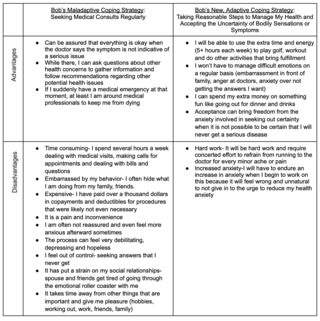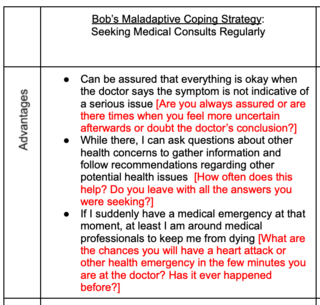Anxiety
Are Your Coping Strategies Increasing Your Health Anxiety?
Learn how to assess the impact of your behaviors with a cost benefit analysis.
Posted September 28, 2021 Reviewed by Abigail Fagan
Key points
- People often engage in behaviors to reduce health anxiety without realizing such behaviors may actually be increasing their anxiety.
- A cost-benefit analysis is a technique used in CBT to explore the advantages and disadvantages of using a maladaptive coping strategy.
- Cost-benefit analyses can help people explore the advantages of using a more adaptive coping strategy.
So, you get a little anxious about your health. And every once in a while (OK, perhaps a wee bit more) you inspect a mole, search online about a few symptoms or pop over to the doc’s office on your lunch break. Big deal, right? Well, let’s take a closer look and see. It actually might be a bigger deal than you think.
We often don’t realize just how much energy and time go into the things we do. There is a reason you do the things you do when you feel anxious about your health. In fact, all behavior is motivated by something. You believe there are advantages to doing the things you do to reduce health anxiety, or, quite frankly, you wouldn’t do them. For example, some of my clients have certainly been convinced that their excessive body monitoring will help them detect cancer early and increase their chances of survival.
So, no time is better than now to ask the question: Are your health-related behaviors helping you more than they are hurting you? Let’s put these beliefs to the test.
The Cost-Benefit Analysis Defined
With my clients, I use a CBT technique called a cost-benefit analysis to help them explore the advantages and disadvantages of certain thoughts or behaviors. Cost-benefit analyses are a great exercise to identify your reasons for using a certain maladaptive coping strategy so that we can examine the validity of these reasons. Cost-benefit analyses can also help you better understand the consequences, or costs, of using this coping strategy versus the costs and benefits of using a more adaptive coping strategy. What my clients often find is that what they once perceived to be helpful is actually becoming a big pain in their rear.
An Example: Bob
A common coping strategy I have seen my clients use when they worry about their health is to frequent medical facilities. Let’s use an example with someone we will call Bob. The whole situation went a little something like this: (a) Bob noticed heart palpitations; (b) Bob felt anxious because he thought something was wrong; (c) Bob went to the doctor; (d) the doctor examined him, ran a test or two and said he is fine; (e) Bob felt less anxious and went home; (f) two days later he noticed heart palpitations again; (g) Bob was even more anxious (this time something must be really wrong); (h) Bob headed to the urgent care; (i) they sent Bob home with the same conclusion; (j) Bob felt a little better but had more anxiety than before, as he began to conclude the doctors are mistaken; (k) the cycle continued as over the next few weeks Bob showed back up at the urgent care and his doctor’s office a few more times. All exams and test results revealed no concerns.
Bob’s Cost-Benefit Analysis
Bob genuinely believed that going to multiple medical appointments was helping him in some way. The cost-benefit analysis can help one take a step back to look at the big picture of how a behavior is impacting their life. Let’s get started:

After completing all of the advantages and disadvantages of both coping strategies, the final step is to critically analyze (and challenge) the perceived advantages of the maladaptive coping strategy. This is because we often find that some of our assumptions about the advantages are not necessarily accurate.

Additional Strategies and Beliefs to Explore with a Cost-Benefit Analysis
You can use this strategy to examine a variety of maladaptive coping strategies or even to examine the utility of holding maladaptive beliefs. Below are a few examples of other health-anxiety related behaviors or beliefs you might evaluate in a cost-benefit analysis.
Maladaptive Coping Strategies:
- Googling every symptom or bodily sensation
- Reassurance-seeking from friends and family
- Excessive use of preventive behaviors (ensuring close proximity to hospitals, special diets)
- Avoiding doctors, medical exams or tests, reminders of anything health-related (movies, books, conversations, news articles)
- Engaging in excessive worry about health-related issues
Maladaptive Beliefs:
- Holding beliefs about being vulnerable to sickness and disease
- Holding beliefs about the inadequacy of the field of medicine to treat a disease (having lofty or unrealistic standards for medical professionals, tests or exams)
- Holding beliefs about the possibility and need to be 100% certain about the cause of every symptom or bodily sensation
Key Takeaways about Cost-Benefit Analyses
The cost-benefit analysis allows you to take a bird’s eye view of the entire situation. Specifically, it can help you to understand why you do the things you do when you feel anxious about your health. Again, we are always motivated by something. It is necessary to identify your reasons for doing certain things because it allows you to examine the validity of these assumptions. The cost-benefit analysis is also useful for seeing just how much your behavior is negatively impacting your life. And, lastly, it can be refreshing to see specifically how a more adaptive approach could improve your life. Now, it’s your turn. Give it a whirl!


